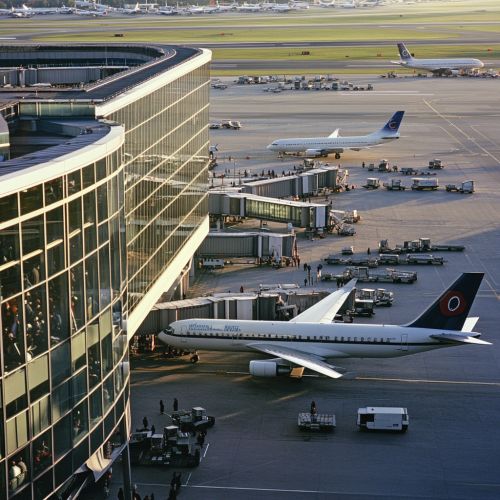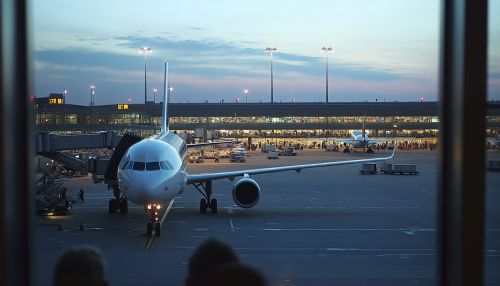Air transportation in the United States
Overview
Air transportation in the United States is a critical component of the country's transportation infrastructure, facilitating the movement of people and goods across vast distances. The U.S. has one of the most extensive and advanced air transportation systems in the world, characterized by a dense network of airports, a large fleet of aircraft, and a complex regulatory framework. This system supports both domestic and international travel, contributing significantly to the economy and connecting the nation to global markets.
History
The history of air transportation in the United States dates back to the early 20th century, with the Wright brothers' first powered flight in 1903 marking a pivotal moment. The subsequent decades saw rapid advancements in aviation technology and infrastructure. The Air Mail Act of 1925 and the Air Commerce Act of 1926 laid the groundwork for commercial aviation by establishing regulations and promoting the development of airways and airports.
During World War II, the U.S. government heavily invested in aviation technology, leading to significant improvements in aircraft design and production. Post-war, these advancements transitioned into the civilian sector, spurring the growth of commercial airlines. The Airline Deregulation Act of 1978 marked another significant milestone, removing government control over fares, routes, and market entry, leading to increased competition and lower prices for consumers.
Infrastructure
The U.S. air transportation infrastructure is composed of a vast network of airports, air traffic control systems, and supporting facilities. The Federal Aviation Administration (FAA) oversees the safety and efficiency of this network, managing over 19,000 airports, including major hubs like Hartsfield-Jackson Atlanta International Airport, Los Angeles International Airport, and Chicago O'Hare International Airport.
Airports
Airports in the United States vary in size and function, from large international hubs to small regional airfields. Major airports serve as critical nodes in the air transportation network, handling millions of passengers annually and facilitating international trade. These airports are equipped with advanced facilities, including multiple runways, extensive terminal buildings, and sophisticated baggage handling systems.


Air Traffic Control
The air traffic control (ATC) system in the United States is one of the most complex in the world, ensuring the safe and efficient movement of aircraft. The FAA operates a network of control towers, terminal radar approach control facilities, and en route centers. These facilities use advanced radar and communication technologies to manage air traffic, prevent collisions, and minimize delays.
Airlines
The airline industry in the United States is dominated by several major carriers, including American Airlines, Delta Air Lines, and United Airlines. These airlines operate extensive domestic and international routes, offering a range of services from low-cost to premium travel. The industry is characterized by intense competition, with airlines continually seeking to improve efficiency and customer satisfaction.
Fleet and Technology
U.S. airlines operate a diverse fleet of aircraft, from small regional jets to large wide-body planes. The industry has seen a shift towards more fuel-efficient models, such as the Boeing 787 Dreamliner and the Airbus A350, in response to rising fuel costs and environmental concerns. Technological advancements, including in-flight connectivity and advanced avionics, have enhanced the passenger experience and operational efficiency.
Economic Impact
Air transportation is a significant contributor to the U.S. economy, supporting millions of jobs and generating billions in revenue. The industry facilitates tourism, business travel, and international trade, playing a crucial role in economic growth. Airports and airlines also contribute to local economies through employment and the development of surrounding areas.
Environmental Considerations
The environmental impact of air transportation is a growing concern, with the industry accounting for a significant portion of greenhouse gas emissions. Efforts to mitigate these impacts include the development of more efficient aircraft, the use of sustainable aviation fuels, and improvements in air traffic management to reduce fuel consumption. The U.S. government and industry stakeholders are actively involved in initiatives to promote sustainable aviation practices.
Regulatory Framework
The regulatory framework governing air transportation in the United States is complex, involving multiple agencies and regulations. The FAA is the primary regulatory body, responsible for ensuring the safety and efficiency of the national airspace system. Other agencies, such as the Transportation Security Administration (TSA) and the Department of Transportation (DOT), play critical roles in security and consumer protection.
Challenges and Future Outlook
The U.S. air transportation industry faces several challenges, including fluctuating fuel prices, evolving security threats, and the need for infrastructure modernization. The industry is also adapting to changing consumer preferences, with an increasing demand for personalized and seamless travel experiences. Looking forward, advancements in technology, such as urban air mobility and autonomous aircraft, have the potential to transform the industry, offering new opportunities and challenges.
